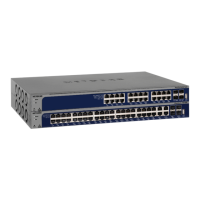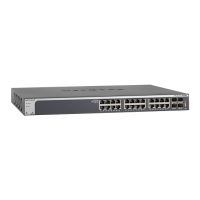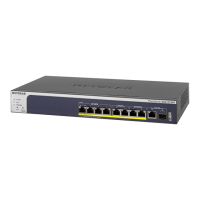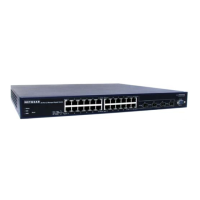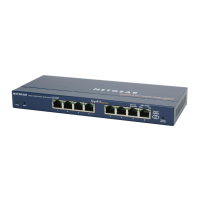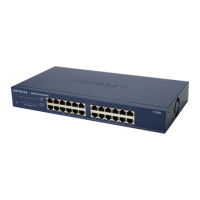3. Check cable routing to make sure that cables are not damaged or creating a safety hazard.
4. Make sure that all equipment is mounted properly and securely.
Step 8: Apply Power and Check the LEDs
The switch does not provide an on/off power switch. The power cord connection controls the power.
Before connecting the power cord, select an AC outlet that is not controlled by a wall switch, which can turn
off power to the switch.
To apply power:
1. Connect the end of the power cord to the AC power receptacle on the back of the switch.
2. Plug the AC power cord into a power source such as a wall socket or power strip.
3. Check to see that the LEDs on the front panel of the switch light correctly.
When you apply power, the Power LED on the switch front panel lights and the ports LEDs for attached
devices light.
If the Power LED does not light, check to see that the power cord is plugged in correctly and that the
power source is good.
Step 9: Manage the Switch
The switch contains built-in web browser–accessible software for viewing, changing, and monitoring the
way it functions. This management software is not required for the switch to work.You can use the ports
without using the management software. However, the management software enables the setup of VLAN
and trunking features and also improves the efficiency of the switch, which results in the improvement of its
overall performance as well as the performance of the network.
After you power on the switch for the first time, you can configure the switch using the web management
interface for advanced setup and configuration of features, or the Smart Control Center program (which
requires a Windows-based computer) for very basic setup. For more information about managing the switch,
see the installation guide on the resource CD and the user manual, which you can download from
downloadcenter.netgear.com.
The switch’s default IP address is 192.168.0.239 and its default subnet mask is
255.255.255.0.
Note
Installation
26
8-Port, 12-Port, and 16-Port Gigabit Smart Managed Pro Switch

